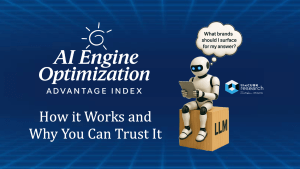The business intelligence (BI) landscape is undergoing a dramatic transformation, driven by the rise of artificial intelligence and the increasing demands of modern enterprises. In a recent conversation with ThoughtSpot CEO Ketan Karkhanis, we explored how AI is reshaping BI and why traditional approaches are no longer sufficient for today’s business needs.
Watch AI is the New BI: ThoughtSpot CEO on Transforming Business Intelligence for the AI Era here:
The Current State of Business Intelligence: Stuck in the Past
Many organizations are still operating with what Karkhanis describes as “flip phone era” business intelligence tools. These legacy systems, which have remained largely unchanged for decades, are struggling to keep pace with the scale of data and the demands of modern business users. The traditional dashboard-centric approach has created significant challenges, with one Fortune 100 company maintaining an overwhelming 180,000 dashboards — a clear indication that current BI solutions aren’t delivering the streamlined insights businesses need.
AI is the New BI: Key Trends Shaping the Future of BI
Several crucial trends are emerging in the business intelligence space. First and foremost is the imperative to integrate AI into BI strategy, which has become a core initiative for organizations across industries, and embracing the reality that AI is the new BI. However, many companies are learning the hard way that DIY approaches to AI integration — such as simply adding an LLM to a data warehouse — fail to address critical requirements like row-level security and complex analytical functions.
Not surprisingly, highly regulated industries like insurance, banking, and pharmaceuticals are leading the charge in adopting AI-powered BI solutions. These sectors recognize the value of AI in handling massive data volumes while maintaining compliance and improving customer experience and they are forging ahead in order to get maximum value from AI. Many are embedding analytics directly into their customer-facing products, transforming data insights into enhanced service delivery.
Beyond Self-Service: The Rise of Data Apps and ThoughtSpot’s Launch of Spotter
The new tech stack is no longer just apps or features inside of apps, but instead agentic systems that are inspired by systems. The concept of self-service BI has largely failed to deliver on its promise. As Karkhanis notes, “Self-service is a hoax. It’s not at all self-service — what we end up doing is just creating more [dashboards].” Organizations are now shifting toward what he calls “data apps,” where insights are seamlessly integrated into the applications where work happens, rather than siloed in separate dashboards.
That’s where Spotter, ThoughtSpot’s AI analyst Spotter, which became publicly available about sixty days ago, comes in. Designed to bring skills of an analyst directly into the Spotter interface, working with the complex data sets of an enterprise spread across different locations, and providing reliable, replicable, contextually rich insights for all users (regardless of skillset), by learning and adapting to business data is what Karkhanis and team see as the path forward.
Spotter’s conversational interface allows users to quickly and easily ask questions directly from the Spotter home page. Users can then dig deeper for granular answers either by asking a follow up question using Spotter’s conversational AI, toggling to token-based search for column-level precision, or drilling down anywhere on AI-generated answers to get to the finest level of granularity.
In my conversation with Karkhanis, he opined that competitors like Qlik, Microsoft, and Looker are the “old generation” of analytics, and that Spotter is the new realm, and the next gen of AI-powered business intelligence. Organizations can embrace a reality of no more self-service dashboards, but instead answers to all their questions within the flow of their work, bringing true empowerment to the end user.
The Path Forward: Autonomous Enterprise Intelligence
The future of business intelligence extends beyond mere automation to what we are hearing more often these days: autonomous enterprise capabilities. This involves AI agents that can proactively drive business workflows based on data insights, creating a continuous feedback loop within organizations. This represents a fundamental shift from traditional BI’s passive reporting approach to an active, intelligence-driven operational model.
Spotter was developed to handle the complexity of enterprise data sets, adapting to the unique nuances of a particular organization, learning the business language of that organization and its users, and providing actionable insights that allow deep drill downs. Spotter can be embedded anywhere: in an app, in Salesforce or ServiceNow, in a workflow, and even on device. Users can get actionable insights based on where they are and where and when they need them. Safety and security are built in from a foundational level, and Spotter will only access data that each individual user has access to. Every insight is actionable, meaning that users can connect the results of an analysis and drive other systems using the insights gleaned from Spotter.
The ThoughtSpot dev team has architected Spotter from the ground up specifically for the enterprise, using foundation/language models for translation capabilities and also adding a relational search engine. It crawls the entirety of enterprise data sets and shows how the English language response translates from natural language (which is what LLMs are good for) to business intelligence. This combination of natural language to data questions is stored for every question, allowing the central BI team to study how the system is operating, see how each question is answered, and see the system automatically learning along the way. Spotter has been trained to handle messy data, and to be able to tackle any data set and any question, using AI to make sense of that data.
Trust and Transparency: Foundation for AI-Powered BI
While AI brings powerful capabilities to business intelligence, trust and transparency remain paramount. As organizations increasingly rely on AI-assisted insights for business decisions, the ability to verify and validate results becomes crucial. ThoughtSpot’s governance capabilities are enterprise-grade, and the company’s approach includes making the underlying SQL queries visible, allowing users to independently verify the accuracy of AI-generated insights, and all access to data follows role-level security and authorizations for each individual user.
Spotter features an “AI trust layer” that ensures there are no hallucinations and, as Karkhanis says “no making up of shit” along the way. And let’s be serious on that front: isn’t that what everyone using AI wants — AI they can trust?
The Bottom Line: Rethinking How Organizations Interact With Data to Drive Better Business Outcomes
This was a great discussion, and I agree with Karkhanis’s assessments of what is ahead for the business intelligence market — without question, AI is the new BI. We are now at a point where organizations can no longer afford to retrofit legacy tools with AI capabilities — they need solutions built from the ground up for the AI era. As enterprises grapple with growing data volumes and increasing demands for actionable insights, the ability to seamlessly integrate AI-powered analytics into business workflows will become a crucial differentiator.
Most importantly, the transformation of BI isn’t just about adding AI capabilities — it’s about fundamentally rethinking how organizations interact with data to drive better business outcomes. As this evolution continues, success will depend on solutions that can deliver not just more dashboards, but actionable insights that drive better experiences and outcomes for both businesses and their customers. I’m looking forward to watching ThoughtSpot continue to evolve under Karkhanis’s leadership.
See more of my coverage here:
Amazon Q: AWS’s Bold Push to Redefine Enterprise AI Integration
New Pega Gen AI Blueprint Features Target the Technical Debt Crisis Head-on



